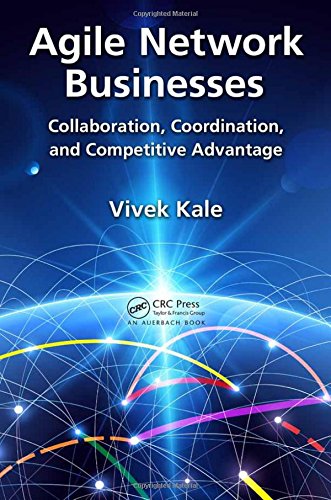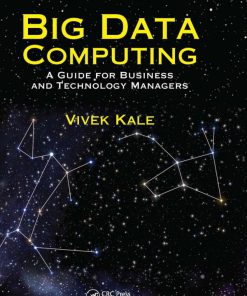Agile network businesses collaboration coordination and competitive advantage 1st Edition by Vivek Kale ISBN 1315351536 9781315351537
$50.00 Original price was: $50.00.$25.00Current price is: $25.00.
Agile network businesses: collaboration, coordination, and competitive advantage 1st Edition by Vivek Kale – Ebook PDF Instant Download/Delivery: 1315351536, 9781315351537
Full dowload Agile network businesses: collaboration, coordination, and competitive advantage 1st Edition after payment

Product details:
ISBN 10: 1315351536
ISBN 13: 978-1315351537
Author: Vivek Kale
“A highly readable and yet comprehensive book on network businesses that have become governable with the advent of cloud and big data computing. Vivek Kale is a master of simplifying the complex world of network theory and its relevance to business.”
―Jagdish N. Sheth, Charles H. Kellstadt Professor of Marketing, Emory University
Agile Network Businesses: Collaboration, Coordination, and Competitive Advantage reflects the shift from traditional networks to virtual and agile networks that enable businesses to operate dynamically, thereby representing markets more closely. This book enables IT managers and business decision-makers to understand clearly what network businesses and enterprises are, what they can do for them, and how to realize them.
Customers in geographically dispersed markets are demanding higher quality products in a greater variety, at lower cost, and in a shorter time. Thus, enterprises have moved from a few centralized and vertically integrated facilities to geographically dispersed networks of capabilities, competencies and resources, which are the core of network businesses. Enterprises are now constructing more fluid network businesses in which each member facility focuses on differentiation and relies increasingly on its partners, suppliers, and customers to provide the rest. Network businesses have emerged as an organizational paradigm for collaboration and coordination across loosely connected individual organizations.
This pragmatic book:
- Introduces network solutions and distributed systems that are a first step towards enabling a network enterprise. It also gives a detailed description of networks and agent system that have paved the road to network enterprises.
- Describes the basics of service-oriented architecture (SOA), cloud computing, and big data that are essential to network enterprises.
- Details the distinguishing aspects of network enterprises, which include virtual enterprises, management of network enterprises, and collaborative network enterprises.
- Covers such major application areas as supply, manufacturing, e-business, platform, social and wireless sensor networks.
- Introduces decision networks in the context of supply chain networks
This book reinterprets the traditional supply chain in terms of the flow of decisions, information, and materials, which leads to reconfiguring the traditional supply chain network into mutually separate decision networks (e.g., fourth-party logistics or 4PL), information networks (e.g., wireless sensor networks), and logistics networks (e.g., third-party logistics or 3PL).
Agile network businesses: collaboration, coordination, and competitive advantage 1st Table of contents:
1. Smart Enterprises
- 1.1 Agile Enterprises
- Stability versus Agility: The balance between maintaining stability while adapting to change.
- Aspects of Agility: Key factors that contribute to organizational agility.
- Principles of Built-for-Change Systems: Designing systems that can rapidly adapt to changes.
- Framework for Change Proficiency: Methods for organizations to build proficiency in managing change.
- 1.2 Enhancing Enterprise Agility
- E-Business Strategy: How digital strategies can improve agility.
- Business Process Reengineering: Reimagining processes to enhance efficiency and adaptability.
- Mobilizing Enterprise Processes: Incorporating mobile solutions into business processes.
- 1.3 Customer Responsiveness
- Salient Aspects of Customer Responsiveness: Key factors that influence how companies respond to customers.
- Customer-Responsive Management: Managing resources effectively to respond to customer demands.
- Networks of Resources, Business Webs, Economics of Customer Responsiveness: How interconnected business networks improve responsiveness.
- 1.4 Network of Enterprises: How organizations interact and collaborate within networks.
- 1.5 Summary: A conclusion summarizing the key principles and strategies of agile enterprises.
2. Business Networks
- 2.1 Network of Enterprises Taxonomy: Various types of business networks and structures, including family networks, entrepreneurial businesses, keiretsu, and international corporate networks.
- 2.2 Alliances
- Types of Network Power: Coordination, cooperation, and collaboration in alliances.
- Alliances for Enhancing Network Power: How alliances can strengthen network capabilities.
- 2.3 Summary: Summary of how networks influence business performance and strategy.
3. Computer Networks
- 3.1 Network Principles: Fundamental concepts of networking, such as protocols and layers.
- 3.2 Types of Networks: Overview of personal, local, metropolitan, and wide-area networks.
- 3.3 Network Models: Detailed explanation of OSI and TCP/IP models.
- 3.4 Internet Services: Various services like email, FTP, VoIP, and streaming.
- 3.5 World Wide Web: The history and applications of the web.
- 3.6 Semantic Web & Internet of Things: Emerging technologies that integrate data and devices.
- 3.7 Summary: Key takeaways on how computer networks function and evolve.
4. Distributed Systems
- 4.1 Parallel and Distributed Computing: Different computing approaches and architectures.
- 4.2 Distributed Databases: Features and characteristics of distributed databases, including transparency and scalability.
- 4.3 Summary: Conclusion on how distributed systems impact enterprise operations.
5. Systems Science, Complexity, and Networks
- 5.1 Systems Science: Principles of systems science and their application to business.
- 5.4 Networks: Key concepts in network theory, including random graphs, small-world networks, and scale-free networks.
- 5.5 Complex Adaptive Systems: Modeling complex systems and their behavior.
- 5.6 Project Management: How systems science informs project management techniques.
- 5.7 Summary: Overview of how systems science and complexity contribute to business networks.
6. Enterprise Networks
- 6.1 Theory of Constraints: How bottlenecks in systems impact overall performance.
- 6.2 Designing the Network of Enterprises: Best practices for designing interconnected enterprise systems.
- 6.6 Characteristics of Network of Enterprises: Exploring network externalities, switching costs, and competitive advantages.
- 6.7 Summary: Summary of enterprise network structures and their implications.
7. Agent Systems
- 7.1 Agent Systems: An exploration of agent properties, architectures, and communication protocols.
- 7.2 Agents for Virtual Enterprises: Using agents to enhance collaboration in virtual environments.
- 7.3 Developing Agent-Based Systems: Approaches to building agent-based systems for e-business.
- 7.4 Summary: How agents facilitate business network activities and enhance automation.
8. Cloud Computing
- 8.1 Cloud Definition and Characteristics: What constitutes cloud computing and its key features.
- 8.4 Cloud Deployment Models: Types of cloud environments, including public, private, hybrid, and community clouds.
- 8.5 Cloud Benefits: Key advantages such as scalability, flexibility, and cost reduction.
- 8.6 Cloud Technologies: Technologies like virtualization and service-oriented architecture (SOA) that enable cloud computing.
- 8.7 Business Processes with SOA: Integrating business processes through service-oriented architectures.
- 8.8 Summary: Final thoughts on the role of cloud computing in modern enterprises.
9. Big Data Computing and Graph Databases
- 9.1 Big Data: Exploring the characteristics of big data, including volume, velocity, variety, and veracity.
- 9.2 Tools and Techniques of Big Data: Technologies and approaches for handling large data sets.
- 9.3 Graph Databases: The use of graph databases like Neo4j and their applications.
- 9.4 Summary: The role of big data and graph databases in network business operations.
10. Network Enterprises
- 10.1 Virtual Organization: Key concepts and advantages of virtual organizations.
- 10.2 Network Enterprise as a Virtual Organization: How network enterprises leverage virtual organizational structures.
- 10.3 Brands as Network Enterprises: Exploring the “brand” as a network entity with shared values and strategies.
- 10.4 Summary: Summary of virtual organizations and brand networks in business.
11. Management of Network Enterprises
- 11.1 Network Enterprises Management: Managing enterprises from a network perspective.
- 11.2 Concept of Supply Chain Management (SCM): Overview of SCM frameworks and challenges.
- 11.3 Supply Chain Performance Framework: Framework for assessing and improving supply chain performance.
- 11.4 Summary: Summary of key strategies for managing network enterprises and supply chains.
12. Collaborative Network Enterprises
- 12.1 Process Networks: Overview of collaborative networks within business processes.
- 12.2 Collaboration Strategies: Different types of collaboration, including transactional, functional, and entrepreneurial collaboration.
- 12.3 Innovation Networks: How innovation networks foster collaboration and knowledge sharing.
- 12.4 Summary: Conclusion on the significance of collaboration in network enterprises.
13. Supplier Networks
- 13.1 Suppliers: Examining the role of suppliers in networked businesses.
- 13.3 Information Networks: The use of sensors and information technologies in supplier networks.
- 13.4 Logistic Networks: The role of logistics and supply chains in business networks.
- 13.5 Summary: Summary of how suppliers and logistics networks impact business performance.
14. Manufacturing Network Enterprises
- 14.1 Manufacturing Network Enterprises (MNEs): Characteristics of MNEs as complex systems.
- 14.2 Cloud-Based Manufacturing Networks: The role of cloud computing in modern manufacturing.
- 14.3 Outsourcing: Exploring outsourcing relationships in manufacturing, with examples like Foxconn.
- 14.4 Summary: Key takeaways on manufacturing networks and cloud-based solutions.
15. E-Business Networks
- 15.1 Business Webs: Analyzing various business web models like Mela B-Web, eBay, Amazon, and Cisco.
- 15.2 Profit Models and Price Fixation: Understanding the economics behind pricing and auctions in e-business networks.
- 15.3 Electronic Procurement: Overview of electronic procurement models and their advantages.
- 15.4 Summary: Summary of e-business strategies and network models.
16. Platform Networks
- 16.1 Product Platforms: Examining platform strategies using examples like Microsoft.
- 16.3 Salient Characteristics of Platform Networks: Key features such as network effects, multisidedness, and lock-in.
- 16.5 Platform Network Examples: Real-world examples of successful platform networks such as Uber and Airbnb.
- 16.6 Summary: Summary of platform networks and their importance to business ecosystems.
17. Social Networks
- 17.1 Social Networks: Key metrics and popular social networks like LinkedIn, Facebook, and Twitter.
- 17.3 Social Network Analysis (SNA): Techniques for analyzing social network performance.
- 17.4 Social Network Performance: Metrics like robustness, efficiency, and effectiveness.
- 17.5 Summary: Insights into the impact of social networks on business and society.
18. Wireless Sensor Networks
- 18.1 Wireless Sensor Networks (WSNs): Characteristics, design challenges, and architecture of WSNs.
- 18.2 Sensor Data Processing: Techniques for gathering and disseminating sensor data.
- 18.4 Data Fusion Mechanisms: Methods of data fusion for enhancing sensor data quality.
- 18.5 Summary: Key takeaways on the role of sensor networks in modern business operations.
People also search for Agile network businesses: collaboration, coordination, and competitive advantage 1st:
agile network builders llc
an agile business exhibits the following characteristics except
what is agile network
business agile methodology
5 agile project management model phases
You may also like…
Business & Economics - Management & Leadership
Strategic Management A Competitive Advantage Approach Concepts and Cases Sixteenth Edition David
Business & Economics
Business & Economics - Sales & Marketing
Business & Economics - Management & Leadership
Strategic Management A Competitive Advantage Approach Concepts Sixteenth Edition David
Cookbooks
Business & Economics - Mathematical Economics
Developing successful business strategies gaining the competitive advantage First Edition Reider
Business & Economics
Big Data Computing A Guide for Business and Technology Managers 1st Edition Vivek Kale












